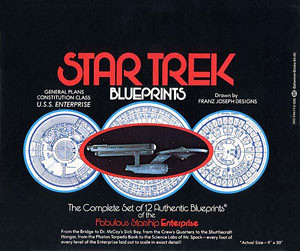Star Trek fans are more than likely familiar with these:
 star-trek-blueprints-cover-sm by SkyKing918, on Flickr
star-trek-blueprints-cover-sm by SkyKing918, on Flickr


The man behind them, Frank (Franz) Joseph Schnaubelt, moved from Chicago to California in 1941, where he applied for work at Consolidated Vultee Aircraft as a draftsman. The sample of work he submitted was a blueprint drawing of a single-engine airplane that happened to be the personal favorite plane of his interviewer. He was hired on the spot. He took a few classes at San Diego State College (aerodynamics, higher math, and engineering), but never attained a degree.
FJ worked for General Dynamics for nearly 30 years as a design engineer, both in the aerodynamics and hydrodynamics divisions. His drawings of planes appeared as illustrations in the Collier's Encyclopedia. He was part of a team that built and flew a full-size reproduction of the A-1, the first military seaplane. (He also designed the logo for the A-1 program.) His biggest claim to fame was the design of the bomb pylons on the F-111 fighter plane, for which he was given an award by Convair for cutting costs without sacrificing quality. His services were loaned to other aircraft companies (such as Ryan) by Convair due to his expertise.
FJ was laid off from General Dynamics in 1969, 3 years after receiving his 25-year pin, replaced by younger men with college degrees. He always referred to the event as "taking an early retirement," but it was not voluntary. In 1973, he decided to draw the Star Trek props and ships as an intellectual exercise. The rest is history. In 1974 and 1975, these works were published by Ballantine Books as the Booklet of General Ship's Plans (a.k.a. the Enterprise Blueprints) and the Star Fleet Technical Manual.
FJ attended Star Trek conventions and book signings from 1975-1983, then withdrew from most public appearances to care for his wife, who was a homebound invalid due to advanced osteoporosis and multiple strokes. He always enjoyed meeting and corresponding with Star Trek fans, and when he did attend conventions, you could always find him in the hotel lobby or on the lounge chairs by the pool, deep in conversation with a cluster of fans, even at 2:00 or 3:00 a.m.
FJ died on June 2, 1994 of sudden cardiac arrest. He was only a few weeks shy of his 80th birthday. He remained bright and active, and continued to live independently until the very end; indeed, he was a guest speaker at a local San Diego science fiction convention only a month before his death.
For more on Mr Schnaubel, see the interview and the following:
And see here for high-resolution copies of the Franz Joseph blueprints, re-scanned at 400 dpi and cleaned up: